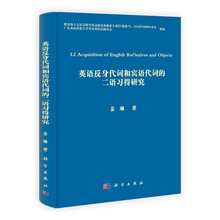Acknowledgements
前言
Abstract
Chapter I Universal Grammar and Second Language Acquisition
1.1 Introduction
1.2 UG and SLA
1.2.1 Principles and Parameters of UG
1.2.2 SLA
1.2.2.1 The Binding of Reflexives
1.2.2.2 The Licensing of Null Objects
1.2.3 Three Major UG-based SLA Theories
1.2.3.1 The Full Transfer Full Access Hypothesis
1.2.3.2 The Minimal Trees Hypothesis
1.2.3.3 The Failed Functional Features Hypothesis
1.3 Summary
Chapter 2 Cross-Linguistic Variation on the Binding of Reflexives and Licensing of Null Objects
2.1 Introduction
2.2 Cross-linguistic Variation on the Binding of Reflexives
2.2.1 The Parameterized Approach
2.2.2 The Move-to-Infl Approach
2.2.3 The Relativized SUBJECT Approach
2.2.4 A New Approach to the Cross-linguistic Variation on the Binding of Reflexives
2.3 Cross-linguistic Variation on the Licensing of Null Objects
2.4 The Binding of Reflexives and the Licensing of Null Objects.
2.5 Summary
Chapter 3 Studies on the Acquisition of Reflexive Binding and Null Objects
3.1 Introduction
3.2 Reflexive Binding in L1 Acquisition
3.3 Reflexive Binding in L2 Acquisition
3.3.1 Hirakawa (1990)
3.3.2 Yuan (1994)
3.3.3 MacLaughlin (1998)
3.3.4 Thomas (1995)
3.3.5 Jiang (2009b)
3.3.6 White et al. (1997)
3.4 Null Objects in L1 Acquisition
3.5 Null Objects in L2 Acquisition
3.5.1 Yuan (1997)
3.5.2 Park (2004)
3.6 Summary
Chapter 4 Main Study
4.1 Introduction
4.2 The Study
4.2.1 Subjects
4.2.2 Materials and Procedure
4.3 Results
4.3.1 Reflexive Binding
4.3.1.1 Group Results
4.3.1.2 Individual Results
4.3.1.3 Summary
4.3.2 Null Objects
4.3.2.1 Group Results
4.3.2.2 Individual Results
4.3.2.3 Summary
4.3.3 Correlation between Reflexive Binding and Null Objects
4.4 Summary
Chapter 5 Discussion
5.1 Introduction
5.2 A-Binding/A'-Binding Asymmetry
5.2.1 Native Language Transfer in L2 Acquisition
5.2.2 Learning Strategies in L2 Acquisition
5.2.3 A New Approach Involving an Interaction of the L1 Grammar and the L2 Input
5.2.3.1 Morphological Complexity of the English Reflexive
5.2.3.2 Binding to Non-Subjects
5.2.3.3 Overt Agreement Morphology
5.2.4 The Implications of the Findings for UG-based SLA Theories
5.3 The Finite/Non-finite Asymmetry in the A-Binding Domain
5.4 The A-bound/A'-bound Null Object Asymmetry in the A'-binding Domain
5.5 Conclusion
References
Appendix Ⅰ The Main Test
Appendix Ⅱ The Proficiency Test

 缺书网
缺书网 扫码进群
扫码进群





